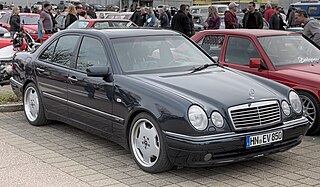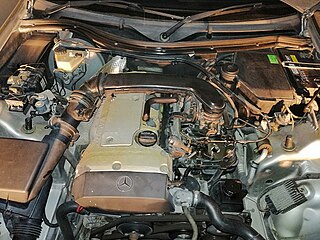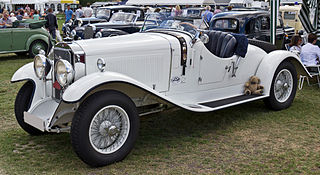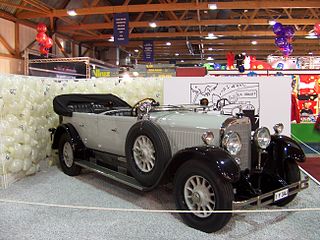Related Research Articles
Mercedes-AMG GmbH, commonly known as AMG, is the high-performance subsidiary of Mercedes-Benz AG. AMG independently hires engineers and contracts with manufacturers to customize Mercedes-Benz AMG vehicles. The company has its headquarters in Affalterbach, Baden-Württemberg, Germany.

The Mercedes-Benz W210 is the internal designation for a range of executive cars manufactured by Mercedes-Benz and marketed under the E-Class model name in both sedan/saloon (1995–2002) and station wagon/estate (1996–2003) configurations. W210 development started in 1988, three years after the W124's introduction.

The Mercedes-Benz W211 is the third generation Mercedes-Benz E-Class made from 2001 to 2009 in sedan/saloon and station wagon/estate configurations – replacing the W210 E-Class models and superseded by the Mercedes-Benz W212 in 2009.

The OM617 engine family is a straight-5 diesel automobile engine from Mercedes-Benz used in the 1970s and 1980s. It is a direct development from the straight-4 OM616. It was sold in vehicles from 1974 to 1991. The OM617 is considered to be one of the most reliable engines ever produced with engines often reaching over 1,000,000 km (620,000 mi) without being rebuilt and is one of the key reasons for Mercedes' popularity in North America in the 1980s, as it was powerful and reliable compared to other automotive diesels of the time. It is also a very popular choice for the use of alternative fuels, mainly straight or waste vegetable oil and biodiesel, although the use of these fuels may cause engine damage over time if not processed properly before use.

The Daimler-Benz DB 603 was a German aircraft engine used during World War II. It was a liquid-cooled 12-cylinder inverted V12 enlargement of the 33.9 Liter DB 601, which was in itself a development of the DB 600. Production of the DB 603 commenced in May 1942, and with a 44.5 liter displacement figure, was the largest displacement inverted V12 aviation engine to be produced and used in front line aircraft of the Third Reich during World War II.

The M111 engine family is a straight-4 automobile engine from Mercedes-Benz, produced from 1992 to 2003. Debuted in the 1992 Mercedes-Benz E-Class (W124), this engine family is relatively oversquare and uses 4 valves per cylinder. All engines in the family use a cast iron engine block and aluminum alloy cylinder head.

Kompressor is a marketing name for forced induction (supercharged) Mercedes-Benz engines. The term is not widely used by other motor manufacturers.

The Mercedes-Benz W08 was a large luxury car produced by Daimler-Benz. It was introduced in Autumn 1928, as Mercedes-Benz's first eight-cylinder passenger car. Also known by various “type numbers”, it remained in production with various modifications and upgrades until the later summer of 1939, the longest lived Mercedes-Benz model of the 1920s and 1930s.

The Benz 10/25 PS was a midsize automobile introduced by Benz & Cie in 1912. The same year stated maximum output was increased which meant a name change to Benz 10/30 PS. The model disappeared for three years following the First World War but returned in 1921. A further power increase in 1926 meant another name change, now to Benz 10/35 PS. Following the "fusion" between the Daimler and Benz companies, production of the Benz 10/35 PS ended in 1927.

The Mercedes 15/70/100 PS was a large automobile introduced by Daimler in 1924. Production continued till 1929 by which time Daimler had merged with Benz & Cie as a result of which the car's name had changed to Mercedes-Benz Typ 400.

The Mercedes 24/100/140 PS was a large luxury car introduced by Daimler of Untertürkheim in 1924. Production continued until 1929 by which time Daimler had merged with Benz & Cie and the car's name changed to Mercedes-Benz Typ 630. The car was conceptually and structurally similar to the contemporary Mercedes 15/70/100 PS, but the 24/100/140 PS was longer, heavier, more powerful, faster and more expensive.

The Mercedes-Benz W03 was a large six-cylinder-engined automobile introduced as the Mercedes-Benz 12/55 PS and, initially, as the Mercedes-Benz Typ 300, by Daimler-Benz at the Berlin Motor Show in October 1926. It was developed in some haste under the manufacturer's Technical Director, Ferdinand Porsche in parallel with the smaller Mercedes-Benz W 01 and the two-litre-engined Mercedes-Benz W02 following the creation of Daimler-Benz, formally in July 1926, from the fusion of the Daimler and Benz & Cie auto-businesses.

Mercedes-Benz W202 is the internal designation for a compact sedan/saloon manufactured and marketed by Mercedes-Benz between 1992–2001, as the first generation of the C-Class, now in its fifth generation. Replacing the 190 series/W201 in June 1993, the C-Class sedan was Mercedes' entry-level model until 1997, when the company launched the A-Class. Production reached 1,847,382 over model years 1994–2000.

The Mercedes-AMG GT 4-Door Coupé is an executive car (E-segment) introduced in 2018 by Mercedes-AMG. It is marketed as a five-door variant of the AMG GT two-door sports car. Despite the name and style, the GT 4-Door Coupé is closely related to E63 wagon with its performance chassis, and is featured by the AMG-specific rear frame and a different front axle for better kinematics.

The Mercedes-Benz C-Class (W206) is the fifth generation of the Mercedes-Benz C-Class which is produced by Mercedes-Benz Group AG since 2021. It replaces the W205 C-Class which has been produced since 2014. The fifth-generation C-Class is available in sedan (W206), station wagon/estate (S206), and long-wheelbase sedan (V206) body styles. The W206 C-Class is based on the Mercedes MRA II rear-wheel drive modular platform also used by the W223 S-Class.
The Mercedes-Benz M08 engine is a naturally-aspirated and supercharged, 4.6-liter and 5.0-liter, straight-8 engine, designed, developed and produced by Mercedes-Benz; between 1928 and 1940.
The Mercedes-Benz M21 engine is a naturally-aspirated, 2.0-liter, straight-6, internal combustion piston engine, designed, developed and produced by Mercedes-Benz; between 1933 and 1936.
The Mercedes-Benz M11 engine is a naturally-aspirated, 2.6-liter, straight-6, internal combustion piston engine, designed, developed and produced by Mercedes-Benz; between 1929 and 1935.
The Mercedes-Benz M04 engine is a naturally-aspirated, 3.0-liter and 3.1-liter, straight-6, internal combustion piston engine, designed, developed and produced by Mercedes-Benz; between 1927 and 1928.
The Daimler-Mercedes M9456 engine is a supercharged and naturally-aspirated, 6.2-liter to 6.4-liter, straight-6, internal combustion piston engine, designed, developed and produced by Mercedes-Benz, in partnership with Daimler; between 1924 and 1929.
References
- ↑ "Mercedes (from 1926 Mercedes-Benz) 15/70/100 hp, from 1928: 15/70/100 hp Type 400". Mercedes-benz-publicarchive.com. Retrieved 10 November 2021.
- ↑ "Mercedes 15/70/100 PS". Thetransportjournal.com. 23 April 2015. Retrieved 10 November 2021.
- ↑ Fayda Bilişim. "Mercedes-Benz Typ 400 (1924 - 1929)". Autovehicle.info. Retrieved 10 November 2021.
- ↑ "1925 Mercedes 15/70/100 HP Tourer | London 2013". Rmsothebys.com. Retrieved 10 November 2021.
- ↑ "Mercedes 15/70/100 hp - MB 24/110/160 hp Model K, 1924 - 1930". Mercedes-benz-publicarchive.com. Retrieved 10 November 2021.